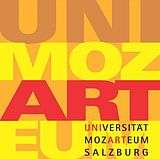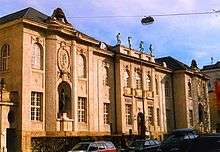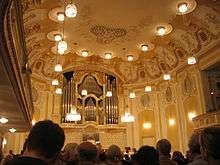Mozarteum University of Salzburg
| Universität Mozarteum Salzburg | |
 | |
| Type | Public art school |
|---|---|
| Established | 1841 |
| Location | Salzburg, Austria |
| Website | https://www.moz.ac.at/en/ |
Universität Mozarteum Salzburg (English: Mozarteum University Salzburg), also known simply as Mozarteum Salzburg, is a university in Salzburg, Austria, which specializes in music and the dramatic arts. It is famous as one of the most respected universities in Europe for music studies and was named after Salzburg native Wolfgang Amadeus Mozart.
History


The predecessor of the Mozarteum Orchestra of Salzburg was the "Cathedral Music Association and Mozarteum", founded in 1841 through the energies of Mozart's widow Constanze Weber Mozart. Its purpose was the "refinement of musical taste with regard to sacred music as well as concerts". Through the 19th century, the concerts of the orchestra, officially named the "Mozarteum Orchestra" in 1908, became the center of Salzburg's musical life.
In Salzburg, the Foundation built and maintains a building with two concert halls, called the Mozarteum. It was constructed 1910–14, designed by the Munich architect Richard Berndl (1875–1955).
The Mozarteum University Salzburg is affiliated with the International Mozarteum Foundation. The recently rebuilt university main building is located at Mirabellplatz 1.
Grand concert hall organ
The original 100-rank grand concert hall organ was built by the Austrian firm Rieger in 1914. A completely new organ in neo-baroque style was installed in 1970 by E.F.Walcker & Cie. This organ was dismantled in 2008. In 2010, a new 50-stop tracker action organ was installed by Hermann Eule Orgelbau, Bautzen. The original 1914 façade was reconstructed.[1]
Stoplist of 2010 Eule Organ Opus 657[2]
|
|
|
|
| |||||||||||||||||||||||||||||||||||||||||||||||||||||||||||||||||||||||||||||||||||||||||||||||||||||||||||||||||||||||||||||
Small concert hall organ
The pipe organ in the small concert hall "Wienersaal", invisibly located in an organ chamber above the stage, was built in 1914 by Rieger with 25 stops and electro-pneumatic action. It was rebuilt in 1941, including a new console and some neobaroque modifications. The organ is in bad condition, but still playable.
Notable alumni
- Barbara Bonney (soprano)
- Marios Joannou Elia (composer and artistic director)
- Leopold Hager (conductor)
- Angelika Kirchschlager (mezzo soprano)
- Herbert von Karajan (conductor)
- Erich Leinsdorf (conductor)
- Igor Levit (pianist)
- Nils Mönkemeyer (violist)
- Carl Orff (composer)
- Alice Sara Ott (pianist)
- Tabea Zimmermann (violist)
Notable teachers
- Barbara Bonney (voice)
- Reinhard Febel (composition)
- Eliot Fisk (guitar)
- Vittorio Ghielmi (viola da gamba)
- Michael Gielen (conducting)
- Pavel Gililov (piano)[3]
- Veronika Hagen-Di Ronza (viola)
- Thomas Riebl (viola)
- Leopold Hager (conducting)
- Nikolaus Harnoncourt (conducting)
- Adriana Hölszky (composition)
- Wolfgang Holzmair (lied and oratorio)
- Karl-Heinz Kämmerling (piano)
- Angelika Kirchschlager (voice)
- Wilma Lipp (voice)
- Tristan Murail (composition)
- Felix Petyrek (composition)
- Ruggiero Ricci (violin)
- Gerhard Röthler (harpsichord)
- Jacques Rouvier (piano)
- Heinrich Schiff (cello)
- Laurence Traiger (composition)
- Gerhard Wimberger (conducting, composition)
References
- ↑ http://www.euleorgelbau.de/orgel-aktuell/orgel-aktuell-salzburg.htm
- ↑ Allmer, Gottfried: Orgeln im Mozarteum und bei den Salzburger Festspielen, Das Orgelforum, Wien 2010, pages 56-79
- ↑ http://en.chopin.nifc.pl/chopin/persons/text/id/2878
External links
- Official site
- The Mozarteum - Salzburg Guide
- Mozarteum Orchestra of Salzburg
- International Mozarteum Foundation website
- Institute for historical and modern-day Mozart Opera Interpretation
Coordinates: 47°48′14″N 13°02′36″E / 47.80389°N 13.04333°E